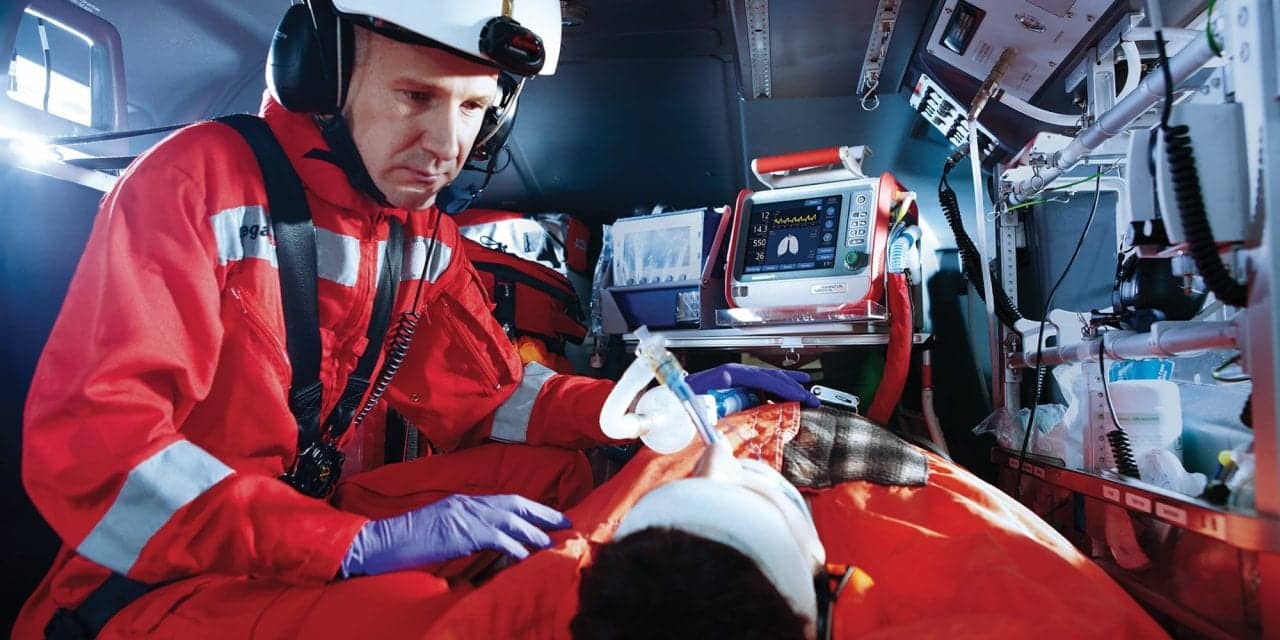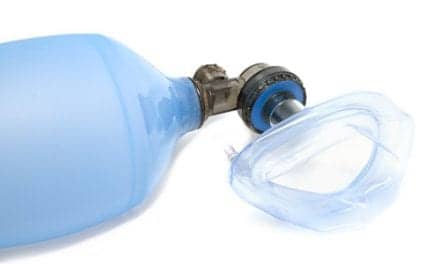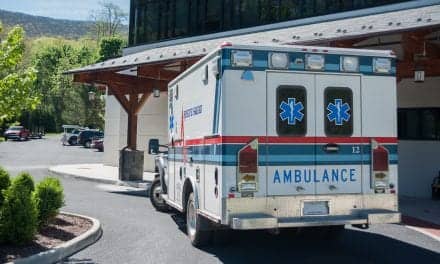When disaster strikes, the expertise and medical support delivered by federal Disaster Medical Assistance Teams, which include RTs, are often the difference between life and death for victims.
By Phyllis Hanlon
In 2008, Hurricane Ike assaulted Galveston Island, Texas, with 120-mph winds and a storm surge between 10 and 20 feet, leaving 17 people dead and causing billions in property damage. Patients flooded Memorial Medical Center of South East Texas–Livingston where Kelly Hamilton, RRT-NPS, CCT, pharmacy tech, was on duty. As part of the immediate disaster response to Ike, a Disaster Medical Assistance Team (DMAT) was dispatched to Galveston and swept into the facility where Hamilton was stationed. She was so impressed with the team and the assistance they provided to victims, she felt driven to join their ranks.
Disaster Medical Assistance Teams operate under the National Disaster Medical System (NDMS), which is part of the Department of Health and Human Services. NDMS was created more than 30 years ago to provide basic medical care and triage patients during disaster situations. There are currently 42 DMAT teams across the country and members include physicians, nurses, physician assistants, nurse practitioners, paramedics, pharmacists, EMTs, police, respiratory therapists, and other medical professionals.
Preparing for Deployment
Hamilton, who also works at Christus Jasper Memorial, eventually joined TX-4 out of Dallas, some five-and-a-half hours away from her hometown of Newton. Her first field training took place in Maryland in July 2011. “There were four DMAT teams and several other agencies, close to 1,000 people, and we had to build and establish a hospital and tents, everything we needed to be functional. During 3 days of drilling, we spent half the time being patients and the other half being caregivers,” she said, citing the training as challenging, but instructive, as she was well prepared for her first deployment when Hurricane Sandy wrecked havoc on Long Island, NY, and coastal New Jersey 16 months later.
Upon arrival in New York in September 2012, Hamilton’s team sprung into action. Strike teams were dispatched to hospitals and shelters to assist the locals with patient care. “One strike team went to evacuate a nursing home that had no power,” she noted. In Long Beach, NY, which was under mandatory evacuation, some residents refused to leave and the team set up a mobile hospital on the soccer field and in the recreation center. “We saw a lot of people with chest pain, shortness of breath, COPD exacerbation due to anxiety, and hypothermia. This environment was not the best to be living in,” Hamilton said. When not using their respiratory skills, RTs were called upon to perform duties unrelated to respiratory care. Hamilton said, “Some team members spent all night outside sweeping snow off the tent. Others kept the generators going all night long.”
David Kissin, BS, RRT-NPS, ACCS, RCP Level IV, training officer for DMAT MA-1 in Boston, has been deployed seven times since 2002—to Guam, Iran, Louisiana, Mississippi, North Dakota, Haiti, and the 2013 Boston Marathon bombing. His first orientation to DMAT came on a windy, frosty September morning when he was summoned to Cape Cod from his home in Portland, Me. “We zip lined off the Bourne Bridge in full gear with a backpack. We then had to walk on the catwalk under the bridge,” he said. “It was Labor Day weekend and cars were buzzing overhead.”
In the second part of the training exercise, Kissin served as a caregiver. He was attached to a litter, cradling a simulated victim. “Other members of the team lowered us down halfway and then changed direction, taking us back up. The exercise built a lot of trust in your fellow team members,” he noted.
During his deployment to Haiti after the 2010 hurricane, Kissin’s team flew in to find all medical infrastructures destroyed. “We initially had no place to set up. Once we did, we saw patients within 5 hours,” he reported, adding that he treated lacerations, broken limbs, and respiratory failures, and attended nine births. When his respiratory skills were not needed, he drew upon his certified nursing assistant expertise, assisted with transport, and delivered some point-of-care services. Trained in lab services, Kissin also did urinalysis, and monitored cardiac enzymes and electrolytes.
Guy Singer, RRT, EMT, LSC (Logistics Section Chief), state fire instructor and member of Metro NY2-DMAT, reports that the respiratory care practitioner’s primary role is to treat any patient who presents with a compromised cardiopulmonary system. “If someone is having an asthma attack, we help the attending physician get the condition under control. We also work closely with the pharmacist and other doctors,” he said. “Within our scope of practice, we can intubate a patient and help arrange for transport to a tertiary care unit at a local hospital.”
However, RTs also execute effective and efficient patient triage during a disaster situation. “We go to different areas and decompress the hospitals so the traumatic patient gets the best care and others who are not so critical go to hospitals farther out,” Singer added.
Equipment Matters
The availability of effective equipment facilitates the job of DMAT members and ensures appropriate care. A 2006 paper reported that disaster ventilators should provide ventilation and oxygenation for both pediatric and adult patients with respiratory failure and should use gas efficiently, work with both AC and non-AC power sources, operate consistently for days to weeks, use standard connections, and be inexpensive to purchase and maintain.1 Small, lightweight, and easy to use, ventilators should have a long battery life and low O2 consumption, and be able to withstand many different types of environments, including biochemical situations. Since many mass casualty events result in acute respiratory distress syndrome (ARDS), the ventilator has to be sophisticated enough to handle this type of lung injury by providing constant volume delivery, monitoring, alarms, and control of airway pressures, PEEP, and Fio2.
Natasha Barany, senior product manager for the LTV Series Ventilators from CareFusion in Yorba Linda, Calif, noted that its Rolling GoPack contains “all the consumables you’d need” for an emergency situation from inline suction to heat and moisture exchangers (HMEs) and “anything needed for ventilation” for adults, infants, and pediatric patients. In addition to the ventilator and related equipment, the case contains an emergency setup card in Spanish and in English and a CD that offers step-by-step instructions. There is a web resource attached to the Rolling GoPack. The emergency preparedness web page has videos and learning materials, Barany said.
Designed in collaboration with DMAT teams and in accordance with stringent regulations from the Society of Critical Care Medicine, the LTV 1200 weighs in at 14.5 pounds and uses any 12-volt power source, even a cigarette lighter. The internal battery allows for transfer from one power source to another without interruption. Barany reported that a specific charging port charges the battery while the ventilator remains inside the pack. She added that the O2 conserve feature reduces oxygen consumption when sources are in short supply, which maximizes the use of available O2.
Billy Hutchison, BA, RRT-NPS, clinical specialist and educator for CareFusion, noted that more than 90% of DMAT teams use CareFusion’s LTV, and with good reason. The device is preset to automatically capture important clinical settings, such as tidal volume, respiratory rate, pressure control, and inspiratory time. “You can fine-tune the numbers. That’s a big appeal. You don’t have to spend so much time with setup, but can immediately get to work on the patient,” he said. “As time allows, you can adjust the settings.”
A variety of variable and fixed alarm settings ensure patient safety and optimize patient care. Additionally, 12 monitors and indicators continually check critical values from peak inspiratory and mean airway pressure to exhaled tidal volume and calculated peak flow.
Having been personally involved in several disaster situations, Hutchison can testify to the LTV’s durability and ease of use. “We used it in Haiti. There were not enough RTs on the ground so we trained Haitians to use it. They picked it up quickly, knowing they had to care for family members,” he said, adding that the original six ventilators they brought to Haiti after the hurricane are still in use there. “Even those without a lot of knowledge can easily operate the LTV.”
Hutchison also noted that during Hurricane Katrina, LTV ventilators facilitated the task of transferring critical patients from ICU ventilators to waiting Medivacs that flew them out of the area.
Industry Input
Impact Instrumentation Inc in West Caldwell, NJ, has specialized in emergency medicine for more than 30 years, and its 731 Series of ventilators, which includes Eagle II, EMV+, and AEV, reflects intensive research and engineering. The company developed the 731 Series with considerable input from RTs working in civilian hospitals, the military, and aeromedical transport in the United States and around the globe. “We found that there are differences in practice patterns between the different environments,” said Len Sherman, owner of Impact Instrumentation. “For instance, pre-hospital care providers are unable to hear alarms in the air ambulance and wanted a visual display of the alarms as well as audible, so we developed an LED alarm indicator system that flashed yellow for low priority alarms and red for medium and high priority alarms along with the audible alarm tone.
“We have the broadest operational temperature range, IPX-4 rating for rain, altitude compensation from -2,000 to 25,000 feet, and airworthiness certification for both fixed and rotary-winged aircraft, so we’re immune to interference from the avionic and the shock and vibration found in this environment,” Sherman said.
He added that the ventilator will run for a minimum of 10 hours and will recharge in approximately 2 hours using any AC or DC source. “The internal compressor provides gas mixing of air and oxygen. The ventilator can use either high-pressure O2 or O2 from a flowmeter or O2 concentrator, and all of the gas from the O2 source and compressor goes into the patient circuit, so there is no gas wasted.” Moreover, the O2 used by the device is based solely on the patient’s Fio2 need.
According to Sherman, the preset startup configurations allow users to begin with adult or pediatric settings, and the Smart Help system guides users to identify and resolve alarms when they occur and prevents the device from being set in a manner harmful for a patient. “All-in-all, we’ve packed a lot of capability into a 9.5-pound ventilator,” he asserted. “In the end, it is a balance to develop a ventilator that provides comprehensive support, complements users working in different environments with different patient populations, while at the same time has an interface that does not overwhelm care providers with limited skill and experience. I think our team successfully achieved this balance, and the feedback from the field seems to support it as well.”
Operational Spectrum
Covidien’s Newport HT70 Plus ventilator, a compact, stackable rolling case with room for necessary accessories and outside connectors for charging batteries, can easily be deployed to a disaster site and helps users remain mobile, according to Cyndy Miller, RRT, Covidien’s manager of Clinical Marketing Respiratory and Monitoring Solutions.
Miller explained that the Newport HT70 Plus is designed for low power and low supplemental oxygen usage, compared to turbine or blower systems. The built-in, hot-swappable Power Pac battery runs for up to 10 hours when fully charged at standard settings; the secondary backup battery operates for up to 30 minutes during a Power Pac battery change or depletion. Both batteries take 3 hours to recharge when plugged into AC at room temperature under standard settings from any 100-240 VAC or 12-24 VDC power source, including a vehicle’s DC auto lighter port. Both are recharged when the EP Case is connected to external power.
The Newport HT70 Plus provides invasive or noninvasive ventilation with A/C, SIMV, and SPONT modes, using volume or pressure control for mandatory breaths and pressure support for spontaneous breaths. Oxygen concentrations of 21% to 100% are available from high pressure or low flow oxygen sources. “Offering this spectrum of ventilation and oxygenation capabilities helps ensure that the ventilator will meet the various patient needs throughout the continuum of care, from rescue to liberation,” said Miller.
The HT70 Plus has a storage and shipping temperature range of -40°C to 65°C and operating temperature range of -18°C to 40°C. “The ventilator is rated and tested for use in helicopter and fixed-wing transports, and rated for use during commercial airline flights. It is made to withstand the physical, electrical, and magnetic field stresses of these environments without interference in either direction,” Miller noted.
Instinctive Performance
In an emergency situation, an RT utilizes skill as well as intuition, and the right equipment can ensure proper patient care. The T1 from Hamilton Medical Inc in Reno, Nev, features a Ventilation Cockpit that gives visual representation of ventilator dependency. “It is designed to improve safety through intuitive operation and monitoring,” said Justin Tse, BS, RRT-NPS, clinical specialist at Hamilton Medical. “It integrates all the data into intuitive graphics that help answer two essential questions: What is my patient’s lung condition and what kind of ventilation do they need?”
Before coming to market, the T1 underwent extensive testing in Europe to meet flight standards and also passed strict testing in the United States for civilian and military application. “Its rugged design and ease of use, along with our closed loop mode Adaptive Support Ventilation, ASV, make it safe for use in all patients. ASV helps promote lung protective strategies, while allowing the clinician more time assessing the patient,” said Tse. “The T1 was developed with the cooperation of many different organizations having input into its design. Rega, one of the most prominent transport organizations in the world, had a large part in setting up the criteria needed for the T1. They were also the first to employ the T1 into use with patients.”
The T1 features the additional benefit of optional ports for connection to hospital monitors. “People in the field can take pictures from the ventilator and send them to the hospital to help manage the patient remotely. Hospital personnel are able to view the patient to offer better support. This results in better patient care and outcomes,” Tse reported.
Joining the Ranks
Federal officials require extensive documentation, including medical credentials, certification and licenses, immunization records, FBI security clearance, and passports, from those interested in joining a team. Due to stringent review, applicants can expect the process to take anywhere from 9 months to a year. Most states have at least one DMAT team and members are required to attend one field training annually.
While training is unpaid, DMAT members are considered federal employees when activated and receive compensation. Also, under the Uniformed Services Employment and Reemployment Rights Act (USERRA), active participants on DMAT teams are guaranteed job security and cannot be penalized for serving during a disaster. Many DMAT members also speak of the personal satisfaction that comes with the job, in helping people endure these dire circumstances. Victims of these disasters often go out of their way to express their gratitude to DMAT teams. “One of the biggest rewards was the sense of being able to help those in need, to be able to turn a situation like [a disaster] into something more positive,” said Kissin, from DMAT MA-1.
Singer, from Metro NY2-DMAT, emphasized that disaster situations demand durable, efficient medical devices to deliver the best patient care, but the experience and teamwork of DMAT personnel like RTs are even more important to ensuring optimal outcomes. “Respiratory therapists need to know how to use tools correctly, but our critical thinking and core skills, as well as working as a team, are the number one piece of equipment RTs need.”
RTs and other medical personnel who are interested in joining a DMAT team can visit the federal website: www.phe.gov/Preparedness/responders/ndms/teams/Pages/dmat.aspx. Many local DMAT teams also have their own websites with contact information.
RT
Phyllis Hanlon is a contributing writer for RT. For more information, contact [email protected].
Reference
1. Rubinson L, Branson RD, Pesik N, Talmor D. Positive-pressure ventilation equipment for mass casualty respiratory failure. Biosecur Bioterror. 2006;4(2):183-94.










